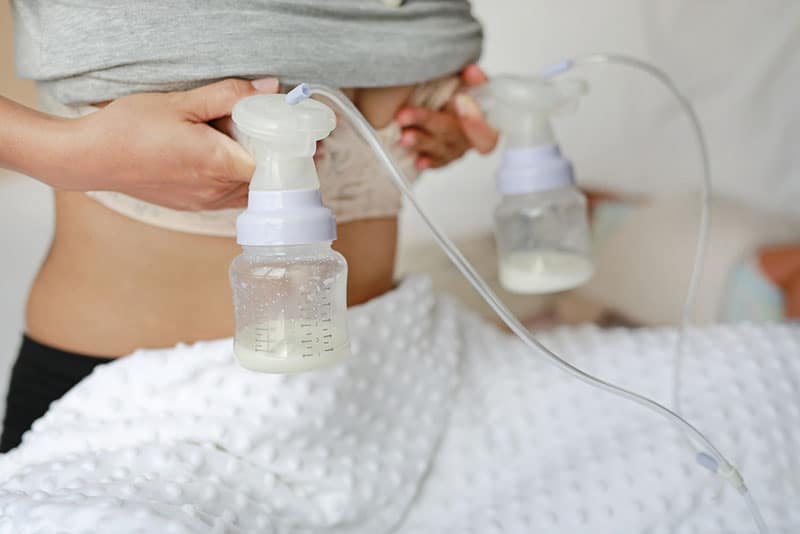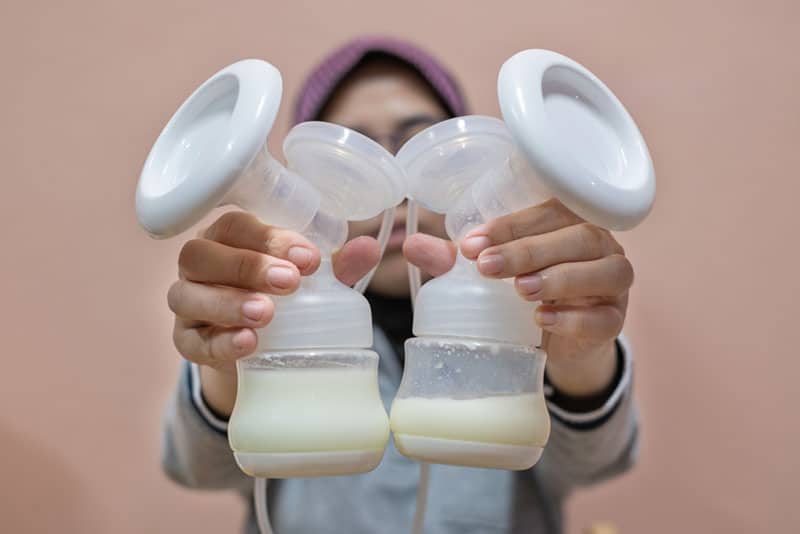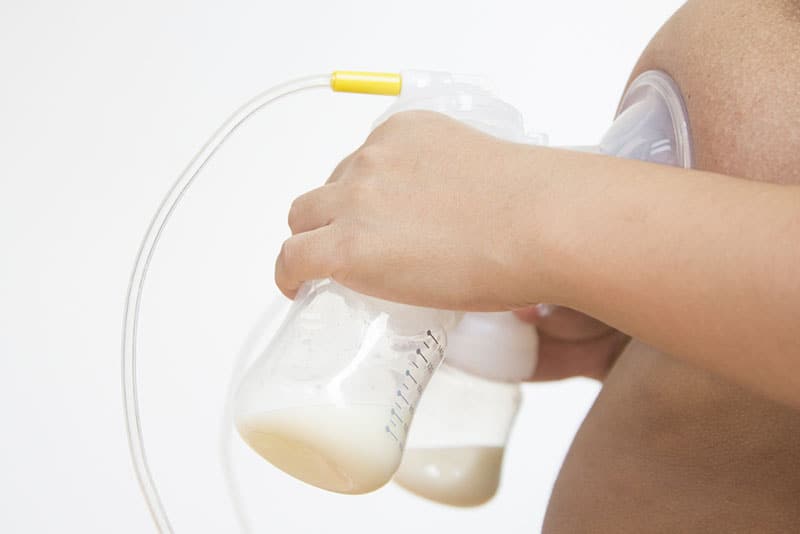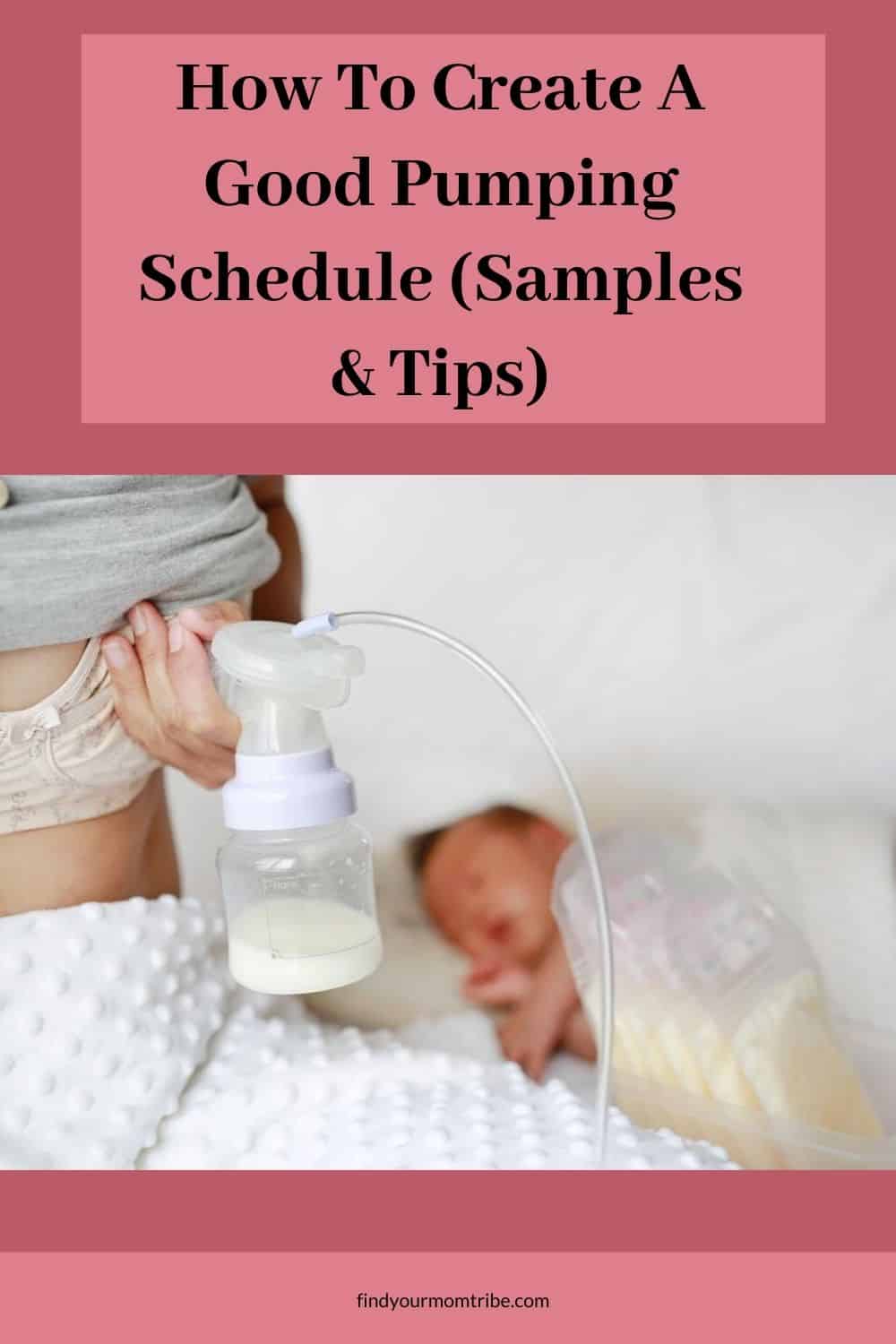Even though breastfeeding is always recommended, sadly not all moms have the opportunity to do it at all times.
That said, figuring out a pumping schedule is a nightmare for every exclusive pumper out there.
How often should you pump? How long should your pumping sessions last? How can you adjust your pumping series to your busy everyday life?
Well, luckily, I’m here to assist you. If you read on, you won’t find only answers to each one of these questions, but also the best sample pumping schedules you can tweak to fit into your lifestyle.
4 Things To Consider Before Creating A Pumping Schedule
1. The baby’s age

The first thing you need to have in mind before making your breastfeeding and pumping schedule fstartis the age of your baby.
You wouldn’t give the same amount of milk to a newborn baby as to a one-year-old, would you?
Well, this is one of the most significant factors that will determine the frequency of your pumping and your entire schedule.
Also, your milk supply is highly affected by how many weeks or months you are postpartum. In the first 12 weeks after you give birth, your hormones affect your milk.
However, after that period is over, your milk supply depends only on the baby’s supply and demand.
Another important question here is whether your baby is born prematurely.
In that case, he’ll need special treatment, which includes a unique pumping schedule as well.
2. Your milk supply

The next thing you have to consider is your milk supply.
Do you have a hard time producing enough milk for your ray of sunshine or is your milk production on overdrive in comparison to your baby’s eating habits?
It’s one thing if you pump because you want to make backup freezer stashes for when you go to work or when you occasionally go out without your baby.
On the other hand, it’s completely different if it serves to increase your milk supply and you need to engage in power pumping.
For example, if your baby refuses to be breastfed right after being born, you have to start pumping immediately if you want to maintain a regular milk supply.
3. Pumping goals

Women pump their milk for different reasons. Each one of these reasons impacts your pumping schedule.
For example, if you want to make a backup freezer stash, you might not even need a strict schedule.
After all, your baby’s eating habits have nothing to do with this milk you have stored.
Also, some women pump because they want to make a donation to the milk bank.
Even though their baby breastfeeds without much trouble, they are perfectly aware that not all mothers are so lucky.
Another reason women may need a pumping schedule is that they’re exclusive pumpers, without breastfeeding. This often is the case if you’ve given birth prematurely.
If you’re an exclusive pumper, you need to have a pretty strict schedule. After all, exclusive pumping (or EPing) is the only source of food for your baby and it’s important for them to have regular meals.
4. The right equipment

Before engaging in this process, you may assume that pumping is no big deal. However, when it becomes your daily routine, you’ll see that it requires a lot of time, effort, and the right gear.
First and foremost, you’ll need a breast pump. It would be best if you could get yourself a double hands-free electric pump.
This will save you the hassle and strength because the electricity does all the work for you. Besides, it will spare you a lot of time because both of your breasts will be pumped simultaneously.
Whatever hands-free electric pump you choose, make sure it is efficient, portable, and powerful. Your electric pump should have suction settings you can adjust and a rechargeable battery.
Also, a nice extra feature would be a timer so you don’t have to worry about measuring your pumping time by yourself.
Another great thing is a breast pumping bag or backpack.
This comes especially in handy to full-time working mums who have returned from maternity leave and will do most of their pumping while at work.
If you’re pumping outside of the comfort of your home, you can’t do it without a special pumping bra.
Besides being made of natural materials that won’t hurt your sensitive nipples, this bra should also come with unhookable cups.
Most models effectively hide the breast pump, so they provide you with maximum comfort. Basically, you can pump your milk without anyone around you having a clue.
You might also want to consider getting a special whiteboard to log your pumping sessions.
Finally, there is absolutely no point in breast-pumping your milk efficiently if you don’t store it the right way. That is exactly why you need appropriate milk storage bags or bottles.
Pros Of A Pumping Schedule
1. Random milk letdowns are a thing of the past

There is not a mom in this world who hasn’t lived through the uncomfortable experience of having her milk let down without her baby suckling. It’s actually a pretty normal reaction.
Scientifically speaking, these letdowns are a natural reflex. However, sometimes they can be the cause of problems.
You see, your body is used to a certain feeding schedule, the same way your baby is. Therefore, it has learned to produce milk at a certain pumping time.
So, what happens when your baby is not around, let alone nursing? Strangely enough, the milk will start leaking, regardless of whether or not the baby needs it.
Well, this is where a breast pump comes to your rescue. Instead of fighting these letdowns and waiting until you come home to your baby, you can express your milk right on the spot.
Basically, if you have an efficient pumping schedule, this way, you’ll never skip your baby’s meal or feel like you’re wasting your precious liquid gold.
2. Increase milk supply

Many breastfeeding moms have a problem with producing less milk than what is needed to fulfill their baby’s needs.
Well, you can resolve this without much trouble when you’re pumping.
For starters, in this case, you have to pump more often than usual. Remember, the amount of milk you produce works on the principle of demand and supply.
It’s actually simple: The more you pump, the more milk your body will produce.
Also, try to pump between nursing sessions. The best amount of time for pumping is 15 minutes per session.
On the other hand, if you’re double pumping simultaneously, most lactation consultants will advise you to continuously pump until your flow stops.
After that, take a break for a short amount of time before resuming.
Before you know it, your body will get used to this schedule and you will increase your milk supply.
Cons Of Exclusive Pumping Schedule
1. It’s exhausting at first!

Even though sticking to a strict pump schedule becomes easy once you get used to it, at first it might be downright exhausting.
After all, you have to wake up in the middle of the night at an exact time.
During the day, you have to leave everything you’re working on and proceed to pump, no matter what you’re doing.
This might take a toll on some moms’ mental health. It’s not enough that you’re sleep-deprived and constantly worried about your baby, now you have another responsibility on your shoulders.
2. Life needs to be adjusted

Once you make this schedule, you have to follow through, no matter how and what.
This means that everything else in your life has to be adjusted to your pumping sessions.
This is especially hard for full-time working moms who’ve returned from their maternity leave.
For example, if your pumping schedule says that you have to wake up at 2 and 4 am, you have to do it regardless of the fact that you’re getting up at work at 6 am.
3. It involves help from others

Following a good pump schedule is an entire family’s job. Even though you’re the one doing most of the work, your partner has to be included as well.
When you’re pumping, you’ll need someone else to take care of the baby or do some other chores.
It is next to impossible when you don’t have anyone’s support and are on your own.
4. No physical contact

When you’re EPing, you’ll miss out on significant physical contact with the baby. This is extremely important for the baby’s emotional progress.
In the case of EPing, make sure to at least keep your baby near your breasts and body. He needs to feel mother’s skin next to him in order to feel protected, safe, and secure.
5. Overfeeding

Overfeeding your baby is easier when you’re exclusively pumping.
You see, it’s faster for a baby to drink milk when you’re bottle-feeding him than when he’s being breastfed.
This is another crucial reason for you to follow the schedule as strictly as possible, since you don’t want your baby to gain unnecessary weight.
Pumping Tips And Tricks To Consider Before Creating A Successful Pumping Schedule
1. Keep your pump clean

Hygiene is everything! I know that you’re a busy pumping mom who is a complete mess right now, but please, don’t forget to keep your pump parts clean.
Get yourself a breast pump brush. Orif this is not an option, just use soap and warm water.
Make sure you let all the pump parts air-dry.
2. Eat healthily

If you want to keep your breast milk supply in order, which will help you stick to your schedule, you’ll have to adapt your diet.
Eat a lot of whole grains, vegetables, fruits, and healthy fats – and don’t forget to include enough vitamins.
3. Wean off pumping gradually

Once you decide it’s time for your baby to be weaned off breast milk, don’t stop with your schedule just like that.
Instead, reduce your pumping sessions and do it gradually.
Also, this is important to prevent engorgement and clogged milk ducts.
If you stop the pumping gradually, there is a lesser chance for your breast tissue to overflow with milk (and possibly blood in the case of infection).
Sample Pumping Schedules
Exclusive pumping schedule for a newborn baby

When you’re a new mom, you’ll have to pump a number of times a day – 8 to 12 times.
That means that you should have a pumping session every 2-3 hours for the first couple of weeks.
This is important since now you have a small milk supply that needs to increase.
However, the good news is that this period won’t last forever and that it gets easier with every week that goes by.
Here is the best sample schedule for your pumping sessions if you have a newborn:
12 am – 4 am – 6 am – 8 am – 10 am – 12 am – 2 pm – 4 pm – 6 pm – 9 pm
If you have trouble following this, try to have at least 8 sessions spaced evenly throughout a 24-hour period.
Whatever you do, make sure you don’t have more than a 4-hour break between sessions.
Another thing to keep in mind is that you’ll produce the most liquid gold during the night since that is when your hormones go wild.
That is why it’s crucial not to miss your night sessions.
Exclusive sample pumping schedule for a 2-month-old baby

At the beginning of this period, you might have an oversupply of breast milk. If that happens, instead of reducing your sessions, keep up with the good work!
You can always freeze the milk for later – you never know when it might come in handy!
Now, you’ll be at 8-10 times during a 24-hour period, which means that you’ll be doing it every 2-3 hours.
Here is the best sample schedule for when your baby is 2-months-old.
2 am – 6 am – 8 am – 10 am – 1 pm – 4 pm – 7 pm – 10 pm
See? It really does get easier.
Exclusive pump schedule for a 3-to-4-month-old baby

Now that you have a settled milk supply, there is no need for pumping breast milk so frequently.
In fact, it will be enough to pump every 3 hours during the day and every 4 hours at night, which is great progress compared to waking up every 2 hours.
2 am – 6 am – 9 am – 12 pm – 3 pm – 6 pm – 10 pm
Yes, there is still one night session here. However, please don’t cut it since you produce the most breast milk then.
Exclusive pump schedule for a 5-to-6-month-old baby

If you’re 5 or 6 months postpartum, 6 pumping sessions will be enough. Your breast milk production is settled, so you probably don’t have a problem with increasing it.
Here is the best pump schedule for when your baby is 5 or 6 months old.
1 am – 6 am – 9 am – 12 pm – 4 pm – 8 pm
Exclusive pump schedule for a 7-to-8-month-old baby

At this time, you’ll have the opportunity to cut another pumping session, since you’ll need to pump only 5 times a day. Congratulations!
You’ve come a long way from the 12 times a day you had at the start.
6 am – 9 am – 1 pm – 5 pm – 10 pm
Your milk supply is already well established and your little one is likely in a sleep routine, so there is no need to wake up at night and pump.
What a relief, right?
Exclusive pump schedule for a 9-to-12-month-old baby

Luckily, your sleeping session can continue.
In this period, it’s enough to pump breast milk just 4 times a day, which means that your life doesn’t have to revolve around your pumping schedule anymore.
6 am – 11 am – 4 pm – 10 pm
Remember that each one of these pumping schedules should only serve as a guideline.
You’re the one who knows what your baby needs, so don’t hesitate to tweak the schedules to your convenience and according to your baby’s needs.
Like this post? Please share or pin it for later. You can also stay in the loop and follow us on Facebook, Instagram and Pinterest.

This post contains affiliate links. Please see our full disclosure or more info.

